Characterizing the Hourly Variation of Urban Heat Islands in a Snowy Climate City during Summer
Abstract
1. Introduction
2. Materials and Methods
2.1. Study Area
2.2. Data Sources
2.3. Methods
2.3.1. Land Use Information Extraction
2.3.2. Temporal Variations of UHI Intensity
2.3.3. Characterizing the Thermal Environment
2.3.4. Air Temperature Profiling
2.3.5. Spatial and Statistical Analysis
3. Results
3.1. Spatial Pattern of Land Use
3.2. Hourly Variations of Air Temperature and UHI Intensity
3.3. Spatiotemporal Pattern of the Thermal Environment
3.4. Profile of Air Temperature
3.5. The Air Temperature Difference among Land Use Types
4. Discussion
4.1. The Temporal Features of UHI Intensity
4.2. The Spatial Features of Air Temperatures
4.3. The Warming and Cooling Rates of Different Land Use
4.4. Limitations
5. Conclusions
- (1)
- The hourly trend of UHI intensity in the summertime was very different from that of air temperature, and looked like an elongated” V”. High air temperature did not indicate severe UHI intensity. There was about a 40% possibility of “inverse UHI intensity” from 08:00 to 13:00.
- (2)
- The spatial pattern of the thermal environment varied significantly in different areas and at different hours. For temperature differences among land use types, paddy land was the coolest in the daytime, while woodland had the lowest temperature during the nighttime and the largest TDDN. It appeared that 23°C was the threshold across which land use was not sensitive to high temperatures.
- (3)
- The differences in the cooling and warming rates among different land use types made the UHI intensity decline sharply after sunrise and increase quickly after sunset. The total land use temperature difference showed negative relationships with both urban and rural temperatures.
Author Contributions
Funding
Acknowledgments
Conflicts of Interest
References
- Howard, L. The Climate of London; Cambridge University Press: Cambridge, UK, 1818; Volume 1. [Google Scholar]
- Oke, T.R. City size and the urban heat island. Atmos. Environ. (1967) 1973, 7, 769–779. [Google Scholar] [CrossRef]
- Rizwan, A.M.; Dennis, L.Y.C.; Liu, C. A review on the generation, determination and mitigation of Urban Heat Island. J. Environ. Sci. 2008, 20, 120–128. [Google Scholar] [CrossRef]
- Goward, S.N. Thermal behavior of urban landscapes and the urban heat island. Phys. Geogr. 1981, 2, 19–33. [Google Scholar] [CrossRef]
- Peng, S.; Piao, S.; Ciais, P.; Friedlingstein, P.; Ottle, C.; Bréon, F.O.-M.; Nan, H.; Zhou, L.; Myneni, R.B. Surface urban heat island across 419 global big cities. Environ. Sci. Technol. 2011, 46, 696–703. [Google Scholar] [CrossRef] [PubMed]
- Renard, F.; Alonso, L.; Fitts, Y.; Hadjiosif, A.; Comby, J. Evaluation of the Effect of Urban Redevelopment on Surface Urban Heat Islands. Remote Sens. 2019, 11, 299. [Google Scholar] [CrossRef]
- Ramakreshnan, L.; Aghamohammadi, N.; Fong, C.S.; Ghaffarianhoseini, A.; Wong, L.P.; Sulaiman, N.M. Empirical study on temporal variations of canopy-level Urban Heat Island effect in the tropical city of Greater Kuala Lumpur. Sustain. Cities Soc. 2019, 44, 748–762. [Google Scholar] [CrossRef]
- Nastran, M.; Kobal, M.; Eler, K. Urban heat islands in relation to green land use in European cities. Urban For. Urban Green. 2019, 37, 33–41. [Google Scholar] [CrossRef]
- Gago, E.J.; Roldan, J.; Pacheco-Torres, R.; Ordóñez, J. The city and urban heat islands: A review of strategies to mitigate adverse effects. Renew. Sustain. Energy Rev. 2013, 25, 749–758. [Google Scholar] [CrossRef]
- Arnberger, A.; Allex, B.; Eder, R.; Ebenberger, M.; Wanka, A.; Kolland, F.; Wallner, P.; Hutter, H.-P. Elderly resident’s uses of and preferences for urban green spaces during heat periods. Urban For. Urban Green. 2016, 21, 102–115. [Google Scholar] [CrossRef]
- Feizizadeh, B.; Blaschke, T. Examining urban heat island relations to land use and air pollution: Multiple endmember spectral mixture analysis for thermal remote sensing. IEEE J. Sel. Top. Appl. Earth Obs. Remote Sens. 2013, 6, 1749–1756. [Google Scholar] [CrossRef]
- Deilami, K.; Kamruzzaman, M.; Liu, Y. Urban heat island effect: A systematic review of spatio-temporal factors, data, methods, and mitigation measures. Int. J. Appl. Earth Obs. Geoinf. 2018, 67, 30–42. [Google Scholar] [CrossRef]
- Lai, D.; Liu, W.; Gan, T.; Liu, K.; Chen, Q. A review of mitigating strategies to improve the thermal environment and thermal comfort in urban outdoor spaces. Sci. Total Environ. 2019, 661, 337–353. [Google Scholar] [CrossRef] [PubMed]
- Rossi, F.; Castellani, B.; Presciutti, A.; Morini, E.; Anderini, E.; Filipponi, M.; Nicolini, A. Experimental evaluation of urban heat island mitigation potential of retro-reflective pavement in urban canyons. Energy Build. 2016, 126, 340–352. [Google Scholar] [CrossRef]
- Kourtidis, K.; Georgoulias, A.; Rapsomanikis, S.; Amiridis, V.; Keramitsoglou, I.; Hooyberghs, H.; Maiheu, B.; Melas, D. A study of the hourly variability of the urban heat island effect in the Greater Athens Area during summer. Sci. Total Environ. 2015, 517, 162–177. [Google Scholar] [CrossRef] [PubMed]
- Huang, Q.; Huang, J.; Yang, X.; Fang, C.; Liang, Y. Quantifying the seasonal contribution of coupling urban land use types on Urban Heat Island using Land Contribution Index: A case study in Wuhan, China. Sustain. Cities Soc. 2019, 44, 666–675. [Google Scholar] [CrossRef]
- Feng, H.; Zhao, X.; Chen, F.; Wu, L. Using land use change trajectories to quantify the effects of urbanization on urban heat island. Adv. Space Res. 2014, 53, 463–473. [Google Scholar] [CrossRef]
- Shen, H.; Huang, L.; Zhang, L.; Wu, P.; Zeng, C. Long-term and fine-scale satellite monitoring of the urban heat island effect by the fusion of multi-temporal and multi-sensor remote sensed data: A 26-year case study of the city of Wuhan in China. Remote Sens. Environ. 2016, 172, 109–125. [Google Scholar] [CrossRef]
- Camilloni, I.; Barrucand, M. Temporal variability of the Buenos Aires, Argentina, urban heat island. Theor. Appl. Climatol. 2012, 107, 47–58. [Google Scholar] [CrossRef]
- Yow, D.M.; Carbone, G.J. The urban heat island and local temperature variations in Orlando, Florida. South. Geogr. 2006, 46, 297–321. [Google Scholar] [CrossRef]
- Voogt, J.A.; Oke, T.R. Thermal remote sensing of urban climates. Remote Sens. Environ. 2003, 86, 370–384. [Google Scholar] [CrossRef]
- Weng, Q. Thermal infrared remote sensing for urban climate and environmental studies: Methods, applications, and trends. ISPRS J. Photogramm. Remote Sens. 2009, 64, 335–344. [Google Scholar] [CrossRef]
- Streutker, D.R. Satellite-measured growth of the urban heat island of Houston, Texas. Remote Sens. Environ. 2003, 85, 282–289. [Google Scholar] [CrossRef]
- Yang, C.; He, X.; Yan, F.; Yu, L.; Bu, K.; Yang, J.; Chang, L.; Zhang, S. Mapping the influence of land use/land cover changes on the urban heat island effect—A case study of Changchun, China. Sustainability 2017, 9, 312. [Google Scholar] [CrossRef]
- Li, Z.-L.; Tang, B.-H.; Wu, H.; Ren, H.; Yan, G.; Wan, Z.; Trigo, I.F.; Sobrino, J.A. Satellite-derived land surface temperature: Current status and perspectives. Remote Sens. Environ. 2013, 131, 14–37. [Google Scholar] [CrossRef]
- Ho, H.C.; Knudby, A.; Xu, Y.; Hodul, M.; Aminipouri, M. A comparison of urban heat islands mapped using skin temperature, air temperature, and apparent temperature (Humidex), for the greater Vancouver area. Sci. Total Environ. 2016, 544, 929–938. [Google Scholar] [CrossRef] [PubMed]
- Rossi, F.; Anderini, E.; Castellani, B.; Nicolini, A.; Morini, E. Integrated improvement of occupants’ comfort in urban areas during outdoor events. Build. Environ. 2015, 93, 285–292. [Google Scholar] [CrossRef]
- Jindal, A. Thermal comfort study in naturally ventilated school classrooms in composite climate of India. Build. Environ. 2018, 142, 34–46. [Google Scholar] [CrossRef]
- Gonçalves, A.; Ornellas, G.; Castro Ribeiro, A.; Maia, F.; Rocha, A.; Feliciano, M. Urban Cold and Heat Island in the City of Bragança (Portugal). Climate 2018, 6, 70. [Google Scholar] [CrossRef]
- Guo, G.; Wu, Z.; Xiao, R.; Chen, Y.; Liu, X.; Zhang, X. Impacts of urban biophysical composition on land surface temperature in urban heat island clusters. Landsc. Urban Plann. 2015, 135, 1–10. [Google Scholar] [CrossRef]
- Hart, M.A.; Sailor, D.J. Quantifying the influence of land-use and surface characteristics on spatial variability in the urban heat island. Theor. Appl. Climatol. 2009, 95, 397–406. [Google Scholar] [CrossRef]
- Wu, H.; Ye, L.-P.; Shi, W.-Z.; Clarke, K.C. Assessing the effects of land use spatial structure on urban heat islands using HJ-1B remote sensing imagery in Wuhan, China. Int. J. Appl. Earth Obs. Geoinf. 2014, 32, 67–78. [Google Scholar] [CrossRef]
- Estoque, R.C.; Murayama, Y.; Myint, S.W. Effects of landscape composition and pattern on land surface temperature: An urban heat island study in the megacities of Southeast Asia. Sci. Total Environ. 2017, 577, 349–359. [Google Scholar] [CrossRef] [PubMed]
- Yuan, F.; Bauer, M.E. Comparison of impervious surface area and normalized difference vegetation index as indicators of surface urban heat island effects in Landsat imagery. Remote Sens. Environ. 2007, 106, 375–386. [Google Scholar] [CrossRef]
- Bertram, C.; Rehdanz, K. The role of urban green space for human well-being. Ecol. Econ. 2015, 120, 139–152. [Google Scholar] [CrossRef]
- Maimaitiyiming, M.; Ghulam, A.; Tiyip, T.; Pla, F.; Latorre-Carmona, P.; Halik, Ü.; Sawut, M.; Caetano, M. Effects of green space spatial pattern on land surface temperature: Implications for sustainable urban planning and climate change adaptation. ISPRS J. Photogramm. Remote Sens. 2014, 89, 59–66. [Google Scholar] [CrossRef]
- Yang, C.; He, X.; Wang, R.; Yan, F.; Yu, L.; Bu, K.; Yang, J.; Chang, L.; Zhang, S. The Effect of Urban Green Spaces on the Urban Thermal Environment and Its Seasonal Variations. Forests 2017, 8, 153. [Google Scholar] [CrossRef]
- Yang, C.; He, X.; Yu, L.; Yang, J.; Yan, F.; Bu, K.; Chang, L.; Zhang, S. The Cooling Effect of Urban Parks and Its Monthly Variations in a Snow Climate City. Remote Sensing 2017, 9, 1066. [Google Scholar] [CrossRef]
- Schrijvers, P.J.C.; Jonker, H.J.J.; Kenjereš, S.; de Roode, S.R. Breakdown of the night time urban heat island energy budget. Build. Environ. 2015, 83, 50–64. [Google Scholar] [CrossRef]
- Oke, T.R. The energetic basis of the urban heat island. Q. J. R. Meteorol. Soc. 1982, 108, 1–24. [Google Scholar] [CrossRef]
- Stewart, I.D.; Oke, T.R. Local Climate Zones for Urban Temperature Studies. Bull. Am. Meteorol. Soc. 2012, 93, 1879–1900. [Google Scholar] [CrossRef]
- Quan, J.; Chen, Y.; Zhan, W.; Wang, J.; Voogt, J.; Wang, M. Multi-temporal trajectory of the urban heat island centroid in Beijing, China based on a Gaussian volume model. Remote Sens. Environ. 2014, 149, 33–46. [Google Scholar] [CrossRef]
- Acero, J.A.; González-Asensio, B. Influence of vegetation on the morning land surface temperature in a tropical humid urban area. Urban Clim. 2018, 26, 231–243. [Google Scholar] [CrossRef]
- Estoque, R.C.; Murayama, Y. Monitoring surface urban heat island formation in a tropical mountain city using Landsat data (1987–2015). ISPRS J. Photogramm. Remote Sens. 2017, 133, 18–29. [Google Scholar] [CrossRef]
- Xu, W.; Li, Q.; Wang, X.L.; Yang, S.; Cao, L.; Feng, Y. Homogenization of Chinese daily surface air temperatures and analysis of trends in the extreme temperature indices. J. Geophys. Res. Atmos. 2013, 118, 9708–9720. [Google Scholar] [CrossRef]
- Roy, D.P.; Wulder, M.; Loveland, T.; Woodcock, C.; Allen, R.; Anderson, M.; Helder, D.; Irons, J.; Johnson, D.; Kennedy, R. Landsat-8: Science and product vision for terrestrial global change research. Remote Sens. Environ. 2014, 145, 154–172. [Google Scholar] [CrossRef]
- Liu, J.; Liu, M.; Tian, H.; Zhuang, D.; Zhang, Z.; Zhang, W.; Tang, X.; Deng, X. Spatial and temporal patterns of China’s cropland during 1990–2000: An analysis based on Landsat TM data. Remote Sens. Environ. 2005, 98, 442–456. [Google Scholar] [CrossRef]
- Wu, J. Urban ecology and sustainability: The state-of-the-science and future directions. Landsc. Urban Plan. 2014, 125, 209–221. [Google Scholar] [CrossRef]
- Colombi, A.; De Michele, C.; Pepe, M.; Rampini, A.; Michele, C.D. Estimation of daily mean air temperature from MODIS LST in Alpine areas. EARSeL eProc. 2007, 6, 38–46. [Google Scholar]
- Philip, G.; Watson, D.F. A precise method for determining contoured surfaces. APPEA J. 1982, 22, 205–212. [Google Scholar] [CrossRef]
- Xiong, Y.; Huang, S.; Chen, F.; Ye, H.; Wang, C.; Zhu, C. The Impacts of Rapid Urbanization on the Thermal Environment: A Remote Sensing Study of Guangzhou, South China. Remote Sens. 2012, 4, 2033–2056. [Google Scholar] [CrossRef]
- Weng, Q.; Lu, D.; Schubring, J. Estimation of land surface temperature–vegetation abundance relationship for urban heat island studies. Remote Sens. Environ. 2004, 89, 467–483. [Google Scholar] [CrossRef]
- Doick, K.J.; Peace, A.; Hutchings, T.R. The role of one large greenspace in mitigating London’s nocturnal urban heat island. Sci. Total Environ. 2014, 493, 662–671. [Google Scholar] [CrossRef] [PubMed]
- Da Silva, V.D.P.R.; de Azevedo, P.V.; Brito, R.S.; da Cunha Campos, J.H.B. Evaluating the urban climate of a typically tropical city of northeastern Brazil. Environ. Monitor. Assess. 2010, 161, 45–59. [Google Scholar] [CrossRef] [PubMed]
- Sarrat, C.; Lemonsu, A.; Masson, V.; Guedalia, D. Impact of urban heat island on regional atmospheric pollution. Atmos. Environ. 2006, 40, 1743–1758. [Google Scholar] [CrossRef]
- Klemm, W.; Heusinkveld, B.G.; Lenzholzer, S.; Jacobs, M.H.; Van Hove, B. Psychological and physical impact of urban green spaces on outdoor thermal comfort during summertime in The Netherlands. Build. Environ. 2015, 83, 120–128. [Google Scholar] [CrossRef]
- Santamouris, M. Cooling the cities—A review of reflective and green roof mitigation technologies to fight heat island and improve comfort in urban environments. Solar Energy 2014, 103, 682–703. [Google Scholar] [CrossRef]
- Eastin, M.D.; Baber, M.; Boucher, A.; Di Bari, S.; Hubler, R.; Stimac-Spalding, B.; Winesett, T. Temporal Variability of the Charlotte (Sub) Urban Heat Island. J. Appl. Meteorol. Climatol. 2018, 57, 81–102. [Google Scholar] [CrossRef]
- Oke, T.R. Initial Guidance to Obtain Representative Meteorological Observations at Urban Sites; World Health Organization: Geneva, Switzerland, 2004. [Google Scholar]
- Santamouris, M. On the energy impact of urban heat island and global warming on buildings. Energy Build. 2014, 82, 100–113. [Google Scholar] [CrossRef]
- Zhang, H.; Qi, Z.-F.; Ye, X.-Y.; Cai, Y.-B.; Ma, W.-C.; Chen, M.-N. Analysis of land use/land cover change, population shift, and their effects on spatiotemporal patterns of urban heat islands in metropolitan Shanghai, China. Appl. Geography 2013, 44, 121–133. [Google Scholar] [CrossRef]
- Debbage, N.; Shepherd, J.M. The urban heat island effect and city contiguity. Comput. Environ. Urban Syst. 2015, 54, 181–194. [Google Scholar] [CrossRef]
- Du, H.; Wang, D.; Wang, Y.; Zhao, X.; Qin, F.; Jiang, H.; Cai, Y. Influences of land cover types, meteorological conditions, anthropogenic heat and urban area on surface urban heat island in the Yangtze River Delta Urban Agglomeration. Sci. Total Environ. 2016, 571, 461–470. [Google Scholar] [CrossRef] [PubMed]
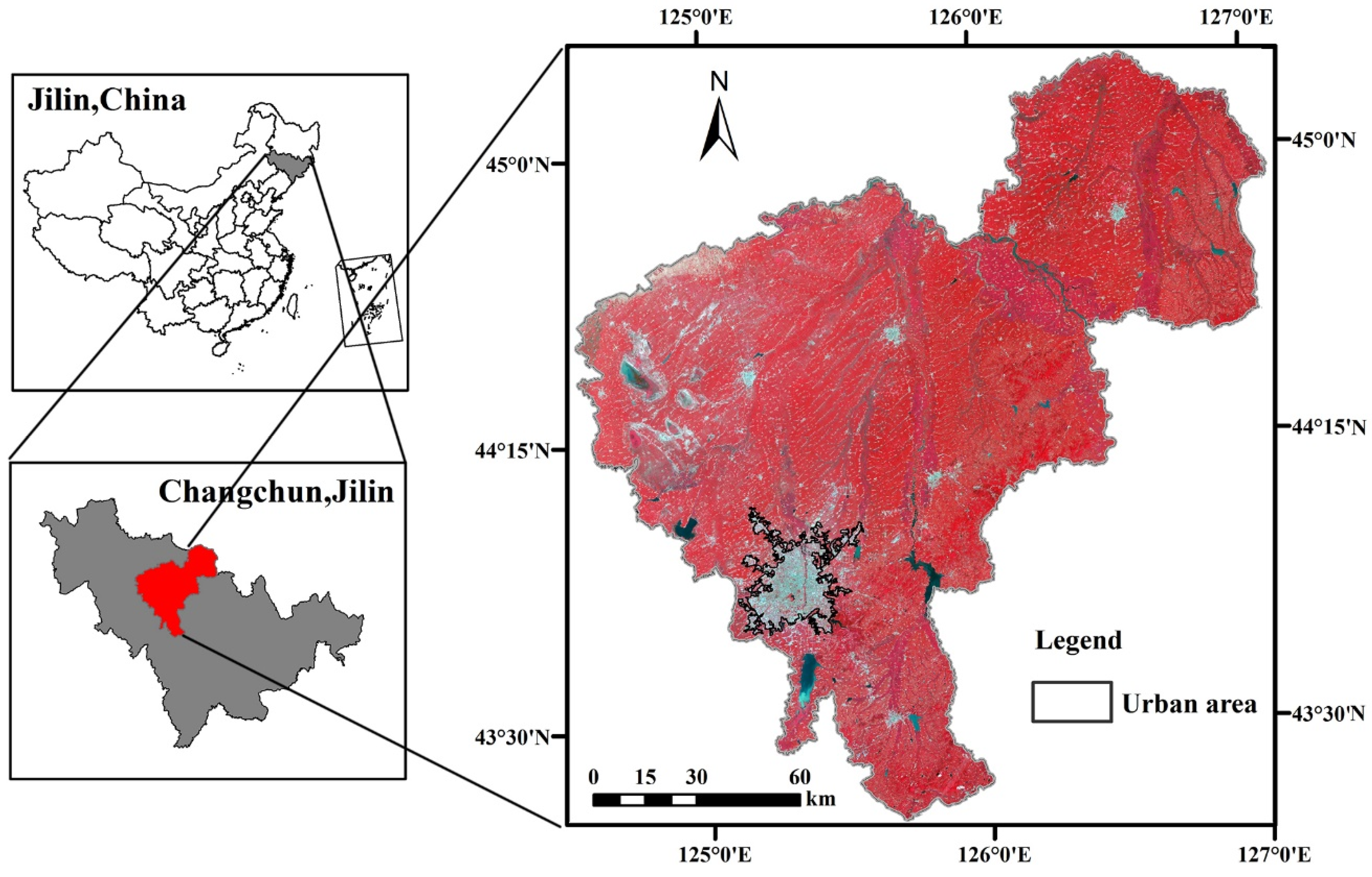
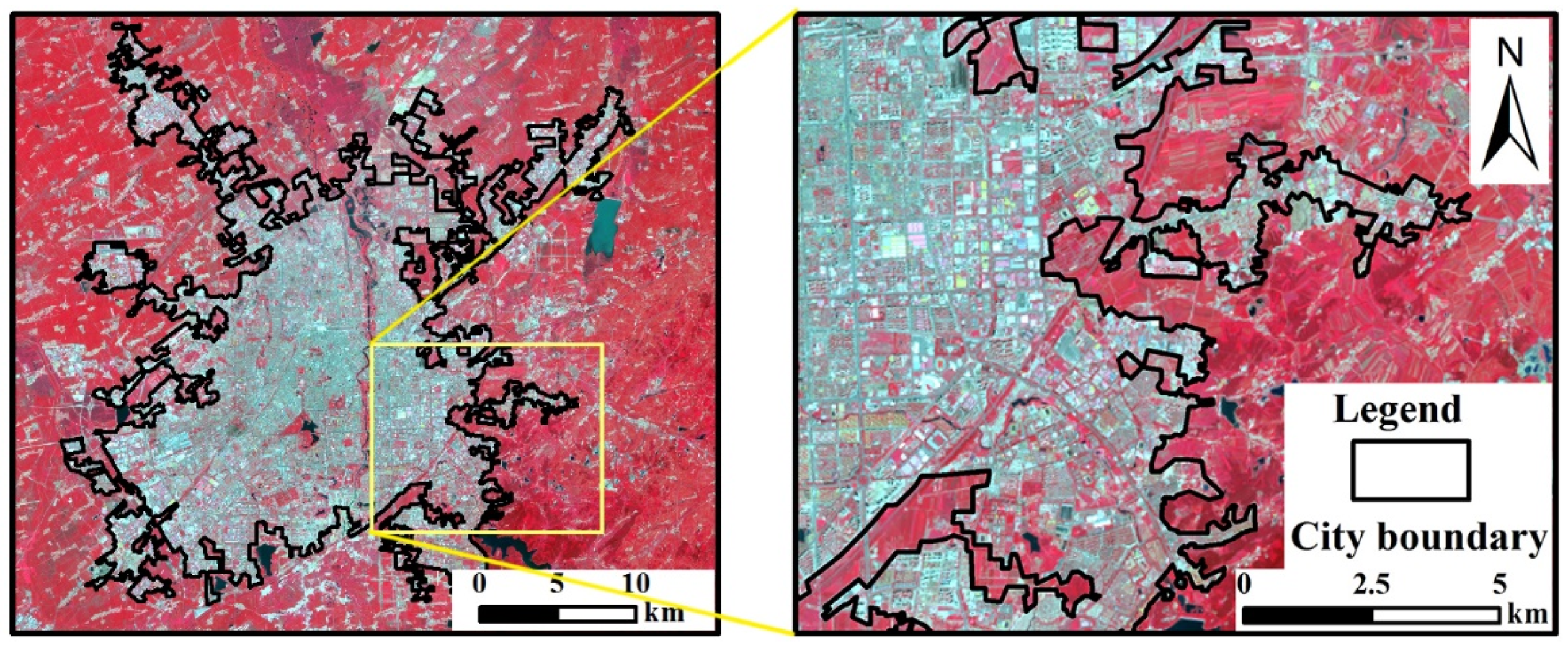
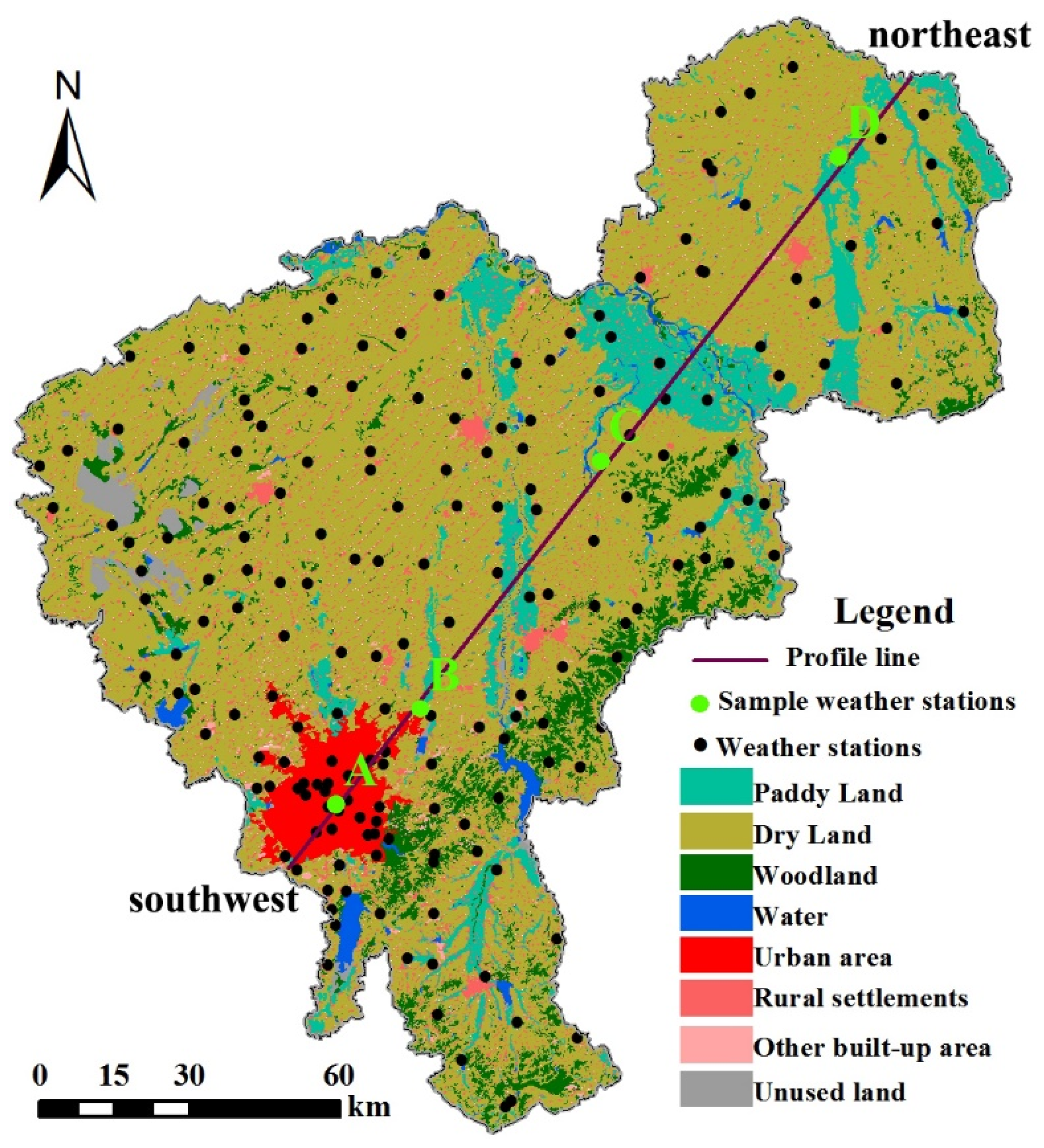
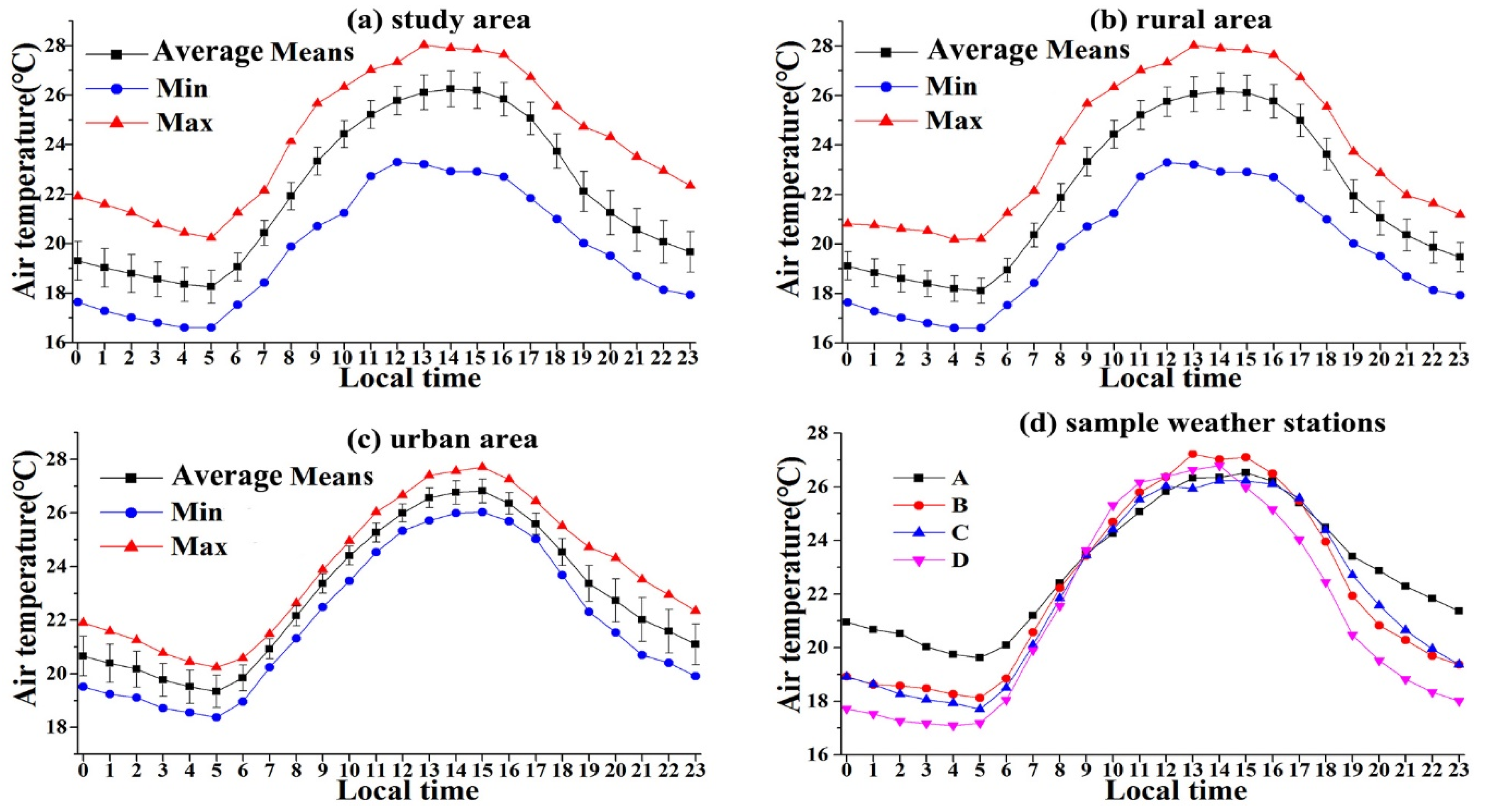


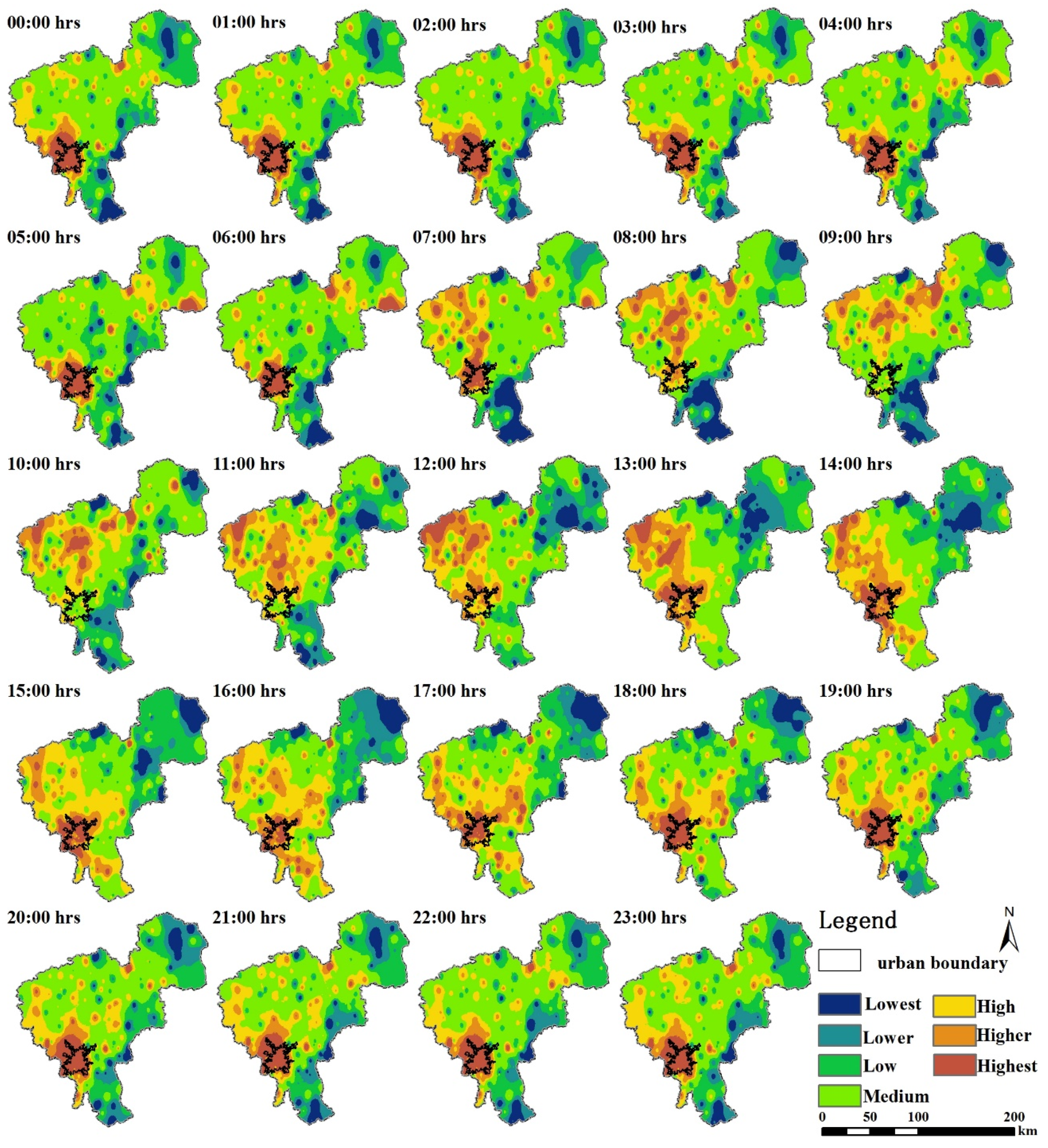
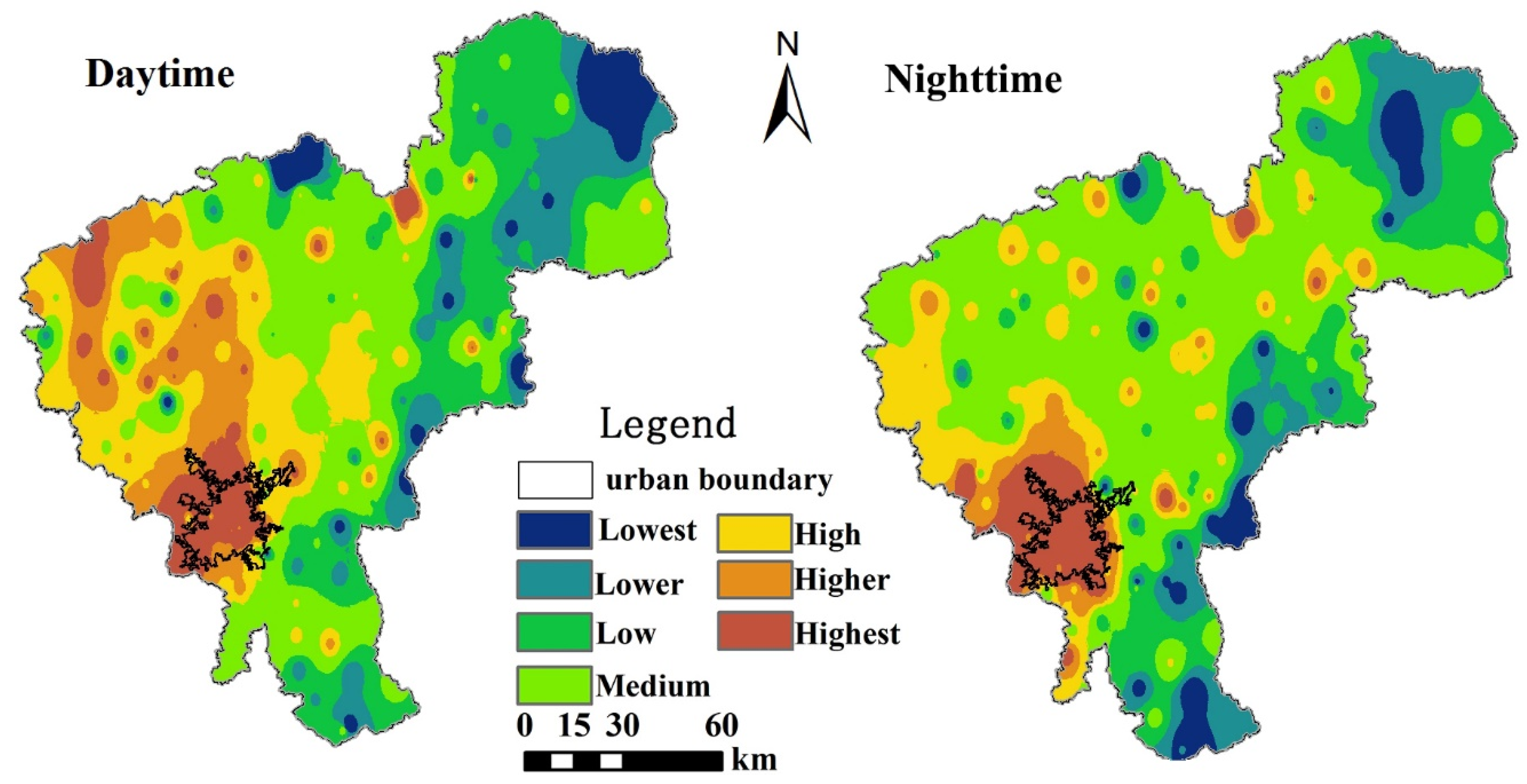
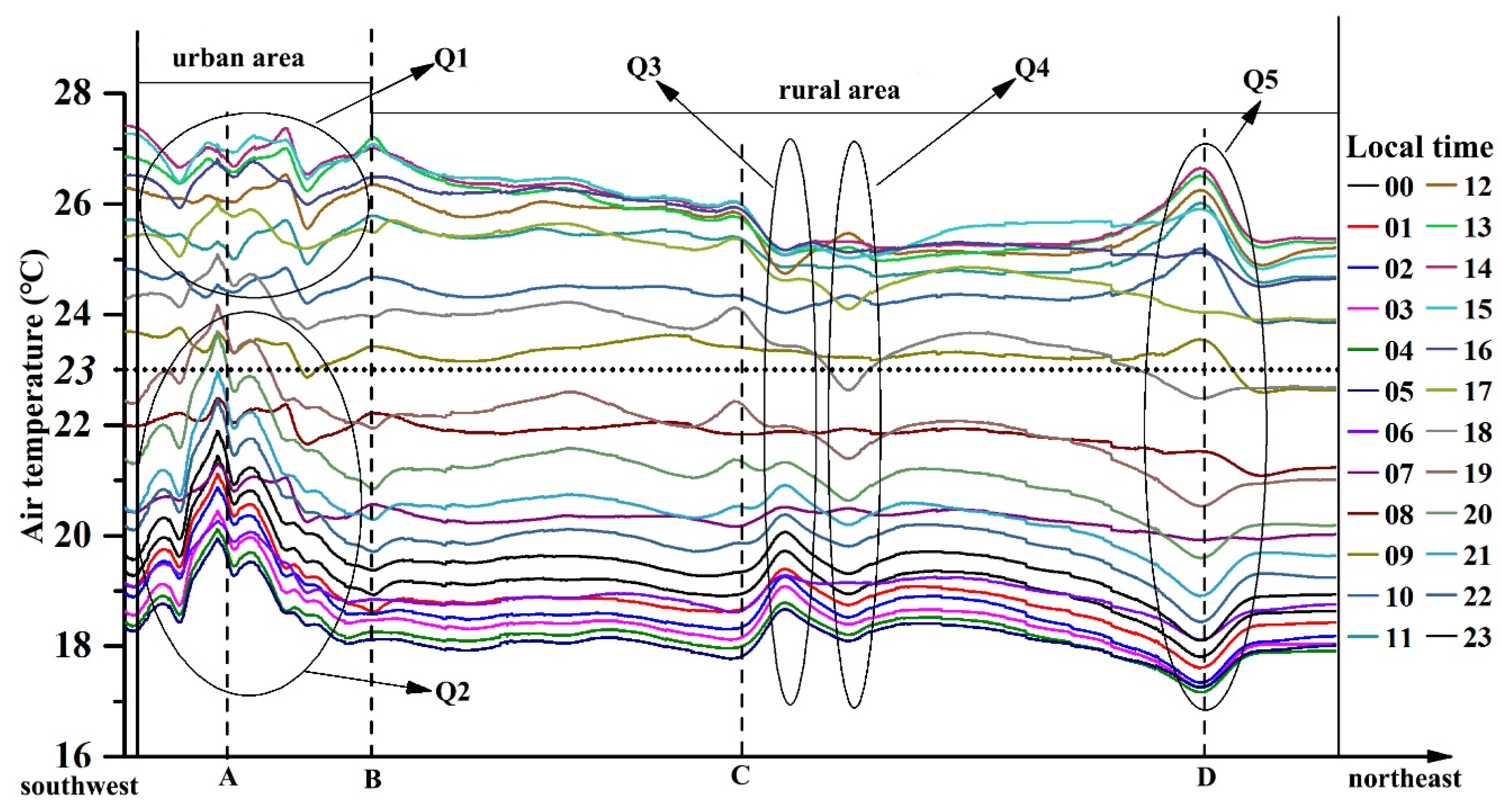
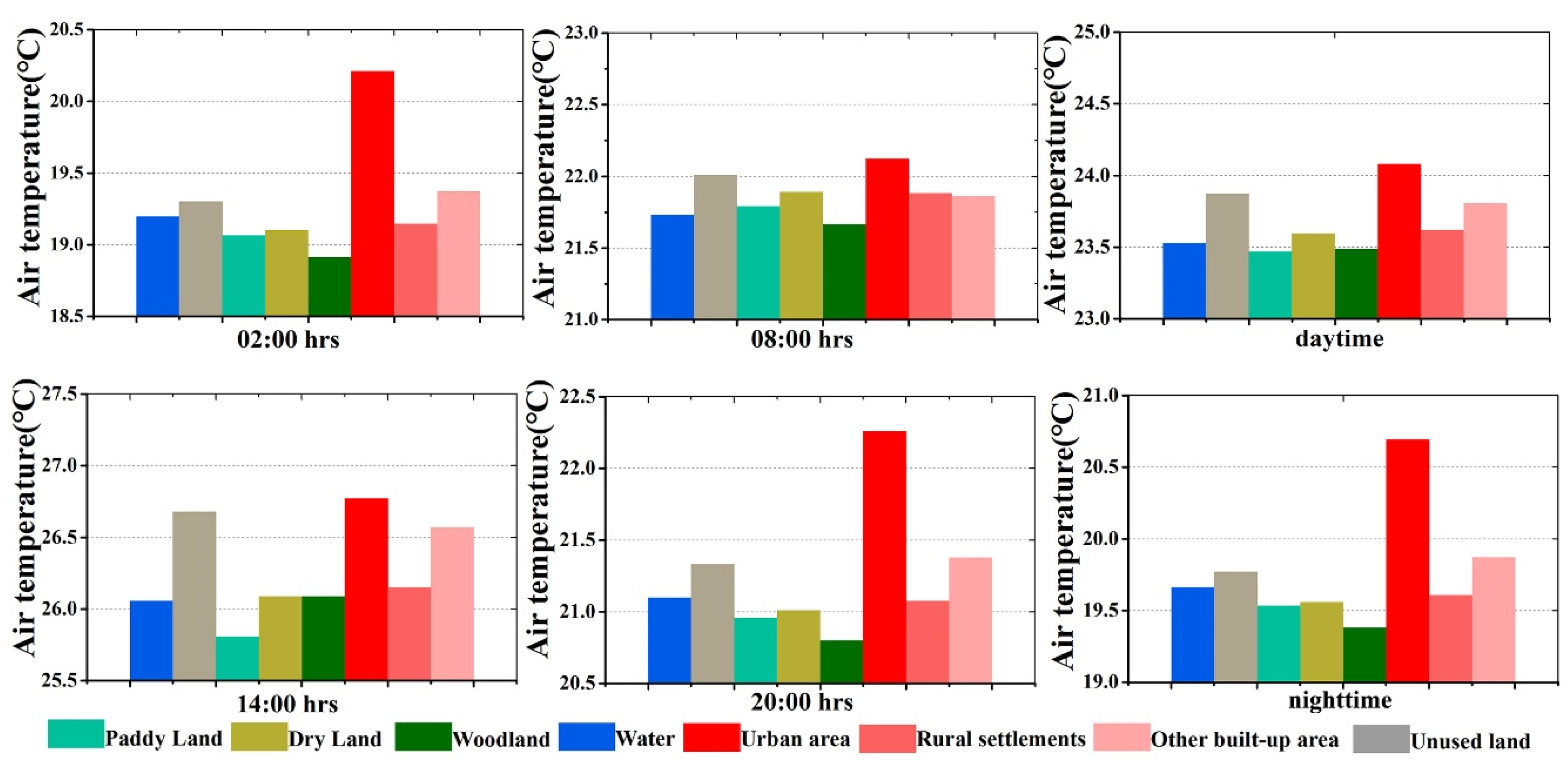

| AT Zones | AT Range |
|---|---|
| lowest | AT < ATmean-1.5S |
| lower | ATmean -1.5S ≤ AT < ATmean − 1.0S |
| low | ATmean -1.0S ≤ AT < ATmean − 0.5S |
| medium | ATmean -0.5S ≤ AT < ATmean + 0.5S |
| high | ATmean +0.5S ≤ AT < ATmean + 1.0S |
| higher | ATmean +1.0S ≤ AT < ATmean + 1.5S |
| highest | AT ≥ ATmean +1.5S |
| Land Use | Urban Area | Dry Land | Paddy Land | Wood Land | Rural Settlements | Other Built-Up Area | Unused Land | Water | Total |
|---|---|---|---|---|---|---|---|---|---|
| Area | 577.5 | 14,250.4 | 1946.1 | 1475.4 | 1556.6 | 115.9 | 315.1 | 356.4 | 20,593.5 |
| Percentage | 2.80 | 69.20 | 9.45 | 7.16 | 7.56 | 0.56 | 1.53 | 1.73 | 100 |
| Maximum Hourly | Minimum Hourly | Daytime | Night | Mean Hourly | ||||||
|---|---|---|---|---|---|---|---|---|---|---|
| Urban | Rural | Urban | Rural | Urban | Rural | Urban | Rural | Urban | Rural | |
| AT | 26.81 | 26.18 | 19.27 | 18.08 | 24.03 | 23.49 | 21.09 | 19.58 | 22.85 | 21.93 |
| SD | 3.89 | 3.83 | 2.48 | 2.14 | 3.21 | 3.03 | 2.68 | 2.25 | 2.94 | 2.65 |
| Time | 15:00 | 14:00 | 05:00 | 05:00 | 05:00-18:00 | 19:00–04:00 | 00:00–23:00 | |||
| Maximum | Minimum | Daytime | Nighttime | Mean | |
|---|---|---|---|---|---|
| UHI intensity | 1.64 | 0.03 | 0.49 | 1.51 | 0.92 |
| standard deviation | 1.01 | 0.75 | 0.65 | 0.82 | 0.62 |
| Time | 20:00 | 10:00 | 05:00–18:00 | 19:00–04:00 | 00:00–23:00 |
| Time | Lowest | Lower | Low | Medium | High | Higher | Highest | H-Region |
|---|---|---|---|---|---|---|---|---|
| 00:00 | 5.42 | 7.77 | 18.47 | 44.26 | 13.82 | 4.54 | 5.73 | 24.09 |
| 01:00 | 5.24 | 6.49 | 18.34 | 47.89 | 11.75 | 4.12 | 6.17 | 22.04 |
| 02:00 | 4.08 | 7.48 | 15.31 | 51.24 | 11.09 | 4.20 | 6.60 | 21.89 |
| 03:00 | 3.74 | 7.54 | 16.19 | 50.10 | 11.69 | 4.33 | 6.42 | 22.44 |
| 04:00 | 3.73 | 8.30 | 15.42 | 47.56 | 14.05 | 4.19 | 6.76 | 25 |
| 05:00 | 3.72 | 7.48 | 16.27 | 51.85 | 10.38 | 3.95 | 6.35 | 20.68 |
| 06:00 | 5.59 | 6.29 | 15.14 | 52.50 | 10.85 | 3.55 | 6.08 | 20.48 |
| 07:00 | 7.63 | 5.69 | 10.52 | 46.51 | 15.21 | 8.84 | 5.60 | 29.65 |
| 08:00 | 9.27 | 8.26 | 8.45 | 42.25 | 16.59 | 10.80 | 4.36 | 31.75 |
| 09:00 | 8.86 | 8.95 | 10.48 | 39.53 | 19.58 | 8.68 | 3.92 | 32.18 |
| 10:00 | 4.74 | 10.30 | 13.64 | 40.64 | 17.06 | 8.80 | 4.82 | 30.68 |
| 11:00 | 5.52 | 11.71 | 13.72 | 31.22 | 21.84 | 11.84 | 4.13 | 37.81 |
| 12:00 | 5.51 | 11.65 | 15.12 | 35.46 | 14.52 | 11.90 | 5.83 | 32.25 |
| 13:00 | 4.78 | 11.86 | 16.75 | 32.13 | 14.57 | 13.46 | 6.44 | 34.47 |
| 14:00 | 5.16 | 13.90 | 16.47 | 28.44 | 17.61 | 12.05 | 6.36 | 36.02 |
| 15:00 | 6.53 | 5.92 | 22.78 | 28.38 | 22.60 | 8.90 | 4.89 | 36.39 |
| 16:00 | 6.10 | 11.30 | 16.78 | 25.28 | 25.51 | 11.33 | 3.70 | 40.54 |
| 17:00 | 6.97 | 7.90 | 17.01 | 31.74 | 20.94 | 11.05 | 4.39 | 36.38 |
| 18:00 | 6.16 | 8.56 | 15.89 | 37.35 | 17.61 | 8.42 | 6.01 | 32.04 |
| 19:00 | 4.88 | 10.43 | 16.80 | 37.31 | 17.82 | 6.75 | 6.01 | 30.58 |
| 20:00 | 4.52 | 12.07 | 17.68 | 40.35 | 13.90 | 5.46 | 6.02 | 25.38 |
| 21:00 | 4.74 | 12.09 | 16.04 | 39.39 | 16.70 | 5.51 | 5.53 | 27.74 |
| 22:00 | 4.10 | 10.75 | 18.23 | 43.19 | 13.18 | 4.64 | 5.91 | 23.73 |
| 23:00 | 4.35 | 10.42 | 17.76 | 40.91 | 15.95 | 4.92 | 5.69 | 26.56 |
| Time | Water Land | Unused Land | Paddy Land | Dry Land | Woodland | Urban Area | Rural Settlements | Other Built-Up Area |
|---|---|---|---|---|---|---|---|---|
| 00:00 | 19.19 ± 0.41 | 19.30 ± 0.32 | 19.06 ± 0.46 | 19.10 ± 0.40 | 18.91 ± 0.42 | 20.20 ± 0.74 | 19.14 ± 0.43 | 19.37 ± 0.60 |
| 01:00 | 18.94 ± 0.44 | 18.99 ± 0.33 | 18.78 ± 0.43 | 18.81 ± 0.38 | 18.66 ± 0.41 | 19.94 ± 0.74 | 18.85 ± 0.41 | 19.10 ± 0.60 |
| 02:00 | 18.72 ± 0.45 | 18.71 ± 0.31 | 18.54 ± 0.42 | 18.57 ± 0.38 | 18.43 ± 0.40 | 19.72 ± 0.73 | 18.62 ± 0.41 | 18.90 ± 0.60 |
| 03:00 | 18.51 ± 0.41 | 18.48 ± 0.28 | 18.38 ± 0.37 | 18.37 ± 0.34 | 18.25 ± 0.37 | 19.38 ± 0.64 | 18.41 ± 0.36 | 18.65 ± 0.51 |
| 04:00 | 18.31 ± 0.38 | 18.22 ± 0.26 | 18.21 ± 0.35 | 18.18 ± 0.33 | 18.06 ± 0.38 | 19.14 ± 0.63 | 18.21 ± 0.35 | 18.43 ± 0.50 |
| 05:00 | 18.22 ± 0.37 | 18.13 ± 0.24 | 18.16 ± 0.32 | 18.10 ± 0.32 | 17.99 ± 0.36 | 19.00 ± 0.59 | 18.12 ± 0.33 | 18.31 ± 0.47 |
| 06:00 | 18.96 ± 0.32 | 19.03 ± 0.21 | 18.98 ± 0.34 | 18.95 ± 0.31 | 18.83 ± 0.35 | 19.62 ± 0.46 | 18.95 ± 0.32 | 19.06 ± 0.41 |
| 07:00 | 20.27 ± 0.32 | 20.52 ± 0.28 | 20.30 ± 0.35 | 20.37 ± 0.32 | 20.24 ± 0.36 | 20.80 ± 0.32 | 20.36 ± 0.34 | 20.41 ± 0.39 |
| 08:00 | 21.73 ± 0.38 | 22.00 ± 0.32 | 21.79 ± 0.45 | 21.89 ± 0.38 | 21.66 ± 0.40 | 22.12 ± 0.23 | 21.88 ± 0.41 | 21.86 ± 0.40 |
| 09:00 | 23.18 ± 0.45 | 23.44 ± 0.32 | 23.27 ± 0.47 | 23.34 ± 0.38 | 23.09 ± 0.39 | 23.40 ± 0.20 | 23.33 ± 0.41 | 23.26 ± 0.36 |
| 10:00 | 24.27 ± 0.39 | 24.60 ± 0.32 | 24.38 ± 0.37 | 24.44 ± 0.35 | 24.21 ± 0.35 | 24.48 ± 0.19 | 24.44 ± 0.37 | 24.44 ± 0.31 |
| 11:00 | 25.06 ± 0.36 | 25.44 ± 0.34 | 25.06 ± 0.42 | 25.20 ± 0.37 | 25.00 ± 0.36 | 25.32 ± 0.24 | 25.21 ± 0.39 | 25.24 ± 0.35 |
| 12:00 | 25.60 ± 0.36 | 26.07 ± 0.32 | 25.52 ± 0.40 | 25.71 ± 0.42 | 25.59 ± 0.37 | 26.02 ± 0.29 | 25.74 ± 0.42 | 25.87 ± 0.38 |
| 13:00 | 25.88 ± 0.54 | 26.52 ± 0.35 | 25.69 ± 0.48 | 25.98 ± 0.55 | 25.95 ± 0.46 | 26.54 ± 0.42 | 26.03 ± 0.55 | 26.35 ± 0.52 |
| 14:00 | 26.05 ± 0.62 | 26.67 ± 0.36 | 25.80 ± 0.55 | 26.08 ± 0.56 | 26.08 ± 0.46 | 26.77 ± 0.47 | 26.15 ± 0.57 | 26.57 ± 0.59 |
| 15:00 | 25.99 ± 0.58 | 26.49 ± 0.31 | 25.79 ± 0.56 | 26.02 ± 0.51 | 26.01 ± 0.45 | 26.80 ± 0.42 | 26.09 ± 0.52 | 26.51 ± 0.51 |
| 16:00 | 25.65 ± 0.52 | 26.05 ± 0.27 | 25.51 ± 0.57 | 25.68 ± 0.50 | 25.68 ± 0.44 | 26.31 ± 0.34 | 25.75 ± 0.50 | 26.07 ± 0.39 |
| 17:00 | 24.89 ± 0.52 | 25.26 ± 0.27 | 24.78 ± 0.53 | 24.91 ± 0.47 | 24.90 ± 0.41 | 25.52 ± 0.32 | 24.97 ± 0.48 | 25.29 ± 0.40 |
| 18:00 | 23.55 ± 0.47 | 23.91 ± 0.28 | 23.44 ± 0.51 | 23.56 ± 0.45 | 23.49 ± 0.40 | 24.37 ± 0.44 | 23.62 ± 0.46 | 23.98 ± 0.48 |
| 19:00 | 21.92 ± 0.44 | 22.25 ± 0.34 | 21.80 ± 0.54 | 21.88 ± 0.47 | 21.72 ± 0.43 | 23.00 ± 0.67 | 21.94 ± 0.49 | 22.27 ± 0.64 |
| 20:00 | 21.09 ± 0.50 | 21.33 ± 0.36 | 20.95 ± 0.56 | 21.00 ± 0.49 | 20.79 ± 0.47 | 22.25 ± 0.79 | 21.07 ± 0.52 | 21.37 ± 0.72 |
| 21:00 | 20.42 ± 0.44 | 20.62 ± 0.34 | 20.31 ± 0.53 | 20.33 ± 0.46 | 20.10 ± 0.46 | 21.53 ± 0.80 | 20.39 ± 0.49 | 20.65 ± 0.68 |
| 22:00 | 19.94 ± 0.46 | 20.08 ± 0.33 | 19.83 ± 0.51 | 19.84 ± 0.45 | 19.60 ± 0.47 | 21.09 ± 0.82 | 19.89 ± 0.47 | 20.17 ± 0.69 |
| 23:00 | 19.54 ± 0.43 | 19.67 ± 0.32 | 19.41 ± 0.47 | 19.45 ± 0.42 | 19.24 ± 0.45 | 20.62 ± 0.77 | 19.50 ± 0.44 | 19.75 ± 0.62 |
| Mean | 21.91 ± 2.90 | 22.16 ± 3.10 | 21.82 ± 2.90 | 21.91 ± 2.98 | 21.77 ± 3.02 | 22.66 ± 2.76 | 21.94 ± 2.98 | 22.16 ± 3.00 |
| Nighttime | 19.66 ± 1.18 | 19.77 ± 1.30 | 19.53 ± 1.18 | 19.55 ± 1.21 | 19.38 ± 1.18 | 20.69 ± 1.26 | 19.60 ± 1.22 | 19.87 ± 1.25 |
| Daytime | 23.52 ± 2.69 | 23.87 ± 2.87 | 23.46 ± 2.63 | 23.59 ± 2.72 | 23.48 ± 2.76 | 24.08 ± 2.69 | 23.62 ± 2.74 | 23.80 ± 2.82 |
| TDDN | 3.86 | 4.10 | 3.93 | 4.03 | 4.10 | 3.38 | 4.01 | 3.93 |
© 2019 by the authors. Licensee MDPI, Basel, Switzerland. This article is an open access article distributed under the terms and conditions of the Creative Commons Attribution (CC BY) license (http://creativecommons.org/licenses/by/4.0/).
Share and Cite
Yang, C.; Wang, R.; Zhang, S.; Ji, C.; Fu, X. Characterizing the Hourly Variation of Urban Heat Islands in a Snowy Climate City during Summer. Int. J. Environ. Res. Public Health 2019, 16, 2467. https://doi.org/10.3390/ijerph16142467
Yang C, Wang R, Zhang S, Ji C, Fu X. Characterizing the Hourly Variation of Urban Heat Islands in a Snowy Climate City during Summer. International Journal of Environmental Research and Public Health. 2019; 16(14):2467. https://doi.org/10.3390/ijerph16142467
Chicago/Turabian StyleYang, Chaobin, Ranghu Wang, Shuwen Zhang, Caoxiang Ji, and Xie Fu. 2019. "Characterizing the Hourly Variation of Urban Heat Islands in a Snowy Climate City during Summer" International Journal of Environmental Research and Public Health 16, no. 14: 2467. https://doi.org/10.3390/ijerph16142467
APA StyleYang, C., Wang, R., Zhang, S., Ji, C., & Fu, X. (2019). Characterizing the Hourly Variation of Urban Heat Islands in a Snowy Climate City during Summer. International Journal of Environmental Research and Public Health, 16(14), 2467. https://doi.org/10.3390/ijerph16142467





